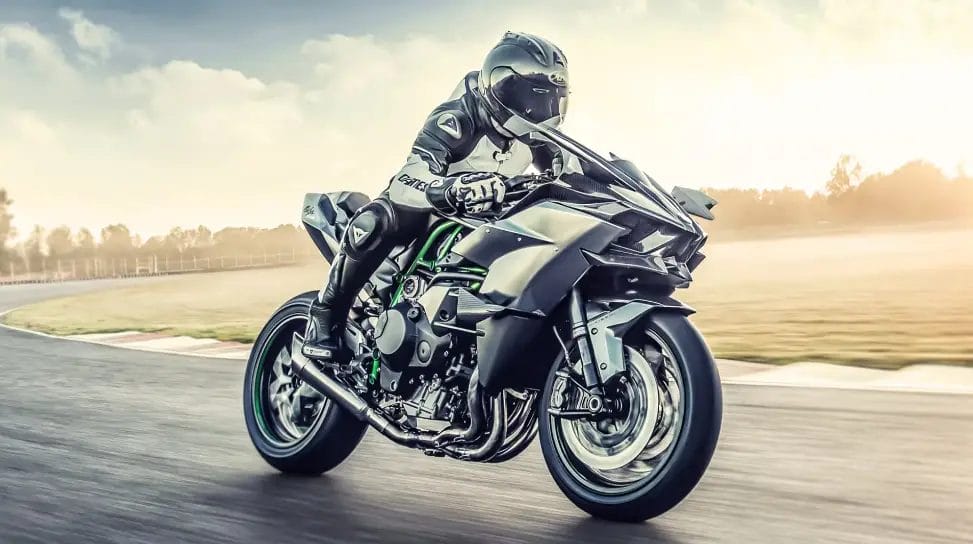Kawasaki was keen to start 2024 with enthusiasm, and it’s safe to say they’ve done a good job of that. Recently, they’ve given fans and enthusiasts around the world something to get excited about, announcing the launch of a fair number of new models and returning to some classics and icons.
However, perhaps the most important takeaway from Kawasaki’s recent announcements is that the company is looking to the future. To this end, Kawasaki has shown us what its first hydrogen-powered motorcycle will look like. Named the Ninja H2 HySE (for now, since it’s a prototype), the Japanese manufacturer is betting big on this model, which could be the next big thing on the road to sustainable mobility. And while we’ll talk more about it in this article, we’ve also rounded up everything Kawasaki has to excite us in the short term.
Eliminator debuts as entry-level cruiser

With Royal Enfield and Harley-Davidson going head-to-head in the entry-level cruiser race with models under 500 cc, Kawasaki has quietly entered the race with the 2024 Eliminator. Although the designation is something Kawasaki fans would recognize, this is a totally new bike with totally new components.
It has a new 451 cc engine derived from the Ninja 400 and Z400, with more torque and a cruiser personality. There’s also a lot of modern technology that comes as standard with the Eliminator, including smartphone connectivity and a more personalized fit for new riders. Although the frame is inspired by the Ninja, the riding height is lower, with a more comfortable 28.9 inches. With a lightweight trellis frame and dual shock rear suspension, it’s a comfortable entry-level cruiser bike.
Ninja 40th Anniversary Edition

As the Ninja turns 40 in 2024, Kawasaki has announced four impressive Ninja 2024 40th Anniversary Edition motorcycles. All the special edition Ninja models will feature a special three-tone paint job inspired by the color of the Ninja ZX-7. While the Ninja ZX-4RR is the entry-level variant, the 2024 Ninja ZX-6R is Kawasaki’s mid-range offering. Then comes the Ninja ZX-10R.
To celebrate the historic victories of the Ninja ZX-7, all four variants will be presented in a three-tone livery: Lime Green/Crystalline White/Blue. The front half of these models will have a light green hue, with the lower fairings sporting a white-blue finish with bold Kawasaki lettering in the same blue.
However, there are no mechanical changes to the 2024 edition of the Ninja, so the specifications remain the same. Of course, you can always choose the Ninja models in the original version.
The Ninja H2R is the fastest production bike in the range

The Ninja H2R is the fastest production bike for 2024, with a 998 cc in-line four-cylinder supercharged engine. It’s also the only supercharged production bike offered by any mainstream manufacturer for the time being. Even at its debut in 2015, it revolutionized motorcycle production and continues its power trend in 2024 as well. Meanwhile, the 2024 Kawasaki Ninja H2, which can be used on public roads, is more affordable, with 227 hp of power and 133.5 Nm of torque.
The new Ninja 7, Ninja e-1 and Z e-1 add electric power to Kawasaki’s 2024 range

Kawasaki has also debuted its first hybrid production bike for 2024, the Ninja 7, which adds EV and ICE power to ensure the best of both worlds. It has a compact electric motor and a 48V lithium-ion battery that combine with a 451cc twin-cylinder engine for a total of 68 hp of power and 59.6 Nm of torque. It also has three driving modes, one of which is EV mode. Here, it will operate as a zero-emissions motorcycle with a clutchless manual or automatic transmission.
Its electric motor alone can produce a maximum of 12 hp of power and 36.6 Nm of torque when operating only in EV mode for short periods. It’s likely to be an exciting motorcycle in Kawasaki’s impressive arsenal.
Of course, speaking of electric motorcycles, Kawasaki is also electrifying two of its iconic motorcycle models, the Ninja and Z, with the announcement of the Ninja e-1 and Z e-1 BEV models. These electric motorcycles can be starter or commuter bikes, designed for city riding, with lower power outputs and removable batteries. They could soon become a complete BEV success for the brand and for Japanese motorcycles in general.
A bold step by Kawasaki towards sustainable mobility

As already mentioned, Kawasaki is also looking to the future and is betting on hydrogen-powered machines to drive it forward. So, at its “Group Vision 2030” conference at the end of last year, it presented its first hydrogen-powered prototype, dubbed the Ninja H2 HySE.
In other words, this is “Hydrogen Small Mobility and Engine Technology”, which is essentially a collaboration of all the top Japanese manufacturers: Kawasaki, Yamaha, Honda, Suzuki and Toyota. According to this collaboration, each brand plays a key role in promoting the development of sustainable mobility.
Although the Ninja H2 HySE is still a prototype, it’s easy to see that the design inspiration came from the Ninja H2 SX, albeit with larger proportions and striking lines and grooves throughout the bike. What’s more, given that hydrogen needs around three times the volume of gasoline to be stored, Kawasaki has developed an interesting solution in the form of large pannier-type tanks on either side of the passenger seat.
As for its power, Kawasaki decided to base the hydrogen-powered prototype on the Ninja H2 series. As a result, it is the world’s first and only supercharged engine for a production motorcycle. According to Kawasaki, the supercharged engine’s forced induction technology helps the hydrogen-fueled combustion engine achieve performance levels close to those of combustion motorcycles







